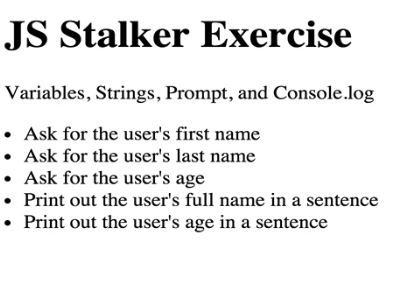Today the course assigned a simple JavaScript exercise:
Here is my steps:
Step One: Create a HTML page and link to the JavaScript File
I create a simple HTML page and give a title "JS Stalker Exercise". Then, I link the HTML page to a new JS file named "stalker.js".
Step Two: Enter variable data in the JS file
In the JS file, I start to write three prompt messages which are asking for user's first name, last name and age.
In order to print out user's full name and age in separate sentences, I set two console.log message. The only thing we need to pay attention is the spacing between each word.
The print sentence has one small space between each word : Your full name is X X. Therefore, in the console.log, we need to set the right space for each word.
Step Three: Test the result
When I open the page, it asks me three pop up questions in orders:
After I answer each questions, I can see the print sentences in the console.







Comments
Post a Comment